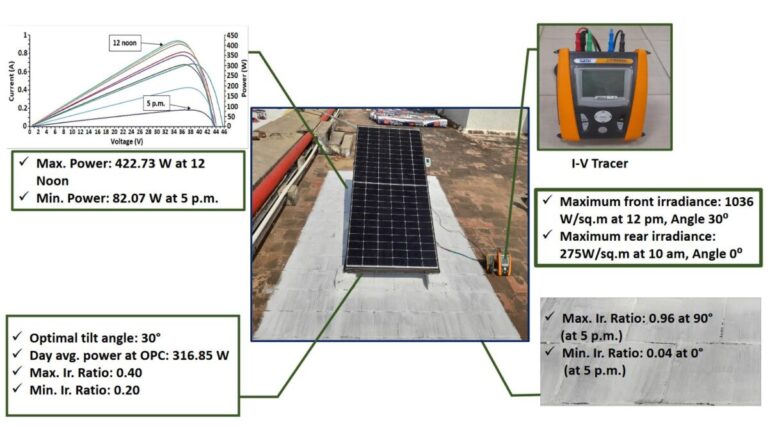Scientists in India analyzed the performance of a double-sided PV module installed on a white-painted ground surface and found that a 30-degree tilt angle outperforms all other tilt angles in terms of power.
Scientists from the Vellore Institute of Technology in India have investigated the influence of tilt angle on energy generation in bifacial PV systems deployed on white-painted ground surfaces.
“We have demonstrated the optimal tilt angle for maximizing energy production from bifacial PV modules, taking into account both direct and reflected irradiation,” said the study’s corresponding author Suprava Chakraborty. pv magazine. “Our research underlines the important role of ground reflectance, especially when using white-painted surfaces, in improving the performance of bifacial PV modules.”
The analysis was performed by continuously adjusting the tilt angle of a 440W bifacial monocrystalline PERC panel supplied by Indian manufacturer Loom Solar Pvt. Ltd. and deployed on the roof of the research institute from 0 to 90 degrees during sunny days in February this year, taking measurements at hourly intervals between 9 a.m. and 5 p.m.
“Eight different inclination angles were chosen, ranging from 0° (horizontal) to 90° (vertical),” the academics explained. “These extreme positions provide different conditions for backside light exposure, allowing for a thorough investigation of their influence on energy generation.”
The different tilt angles were 0, 13, 25, 30, 35, 40, 45 and 90 degrees. “Literature research has consistently shown that bifacial PV modules placed at 30 degrees consistently outperform those at 60 degrees within the tilt range of 30 degrees to 60 degrees,” she added.
The group used a high-precision IV tracer to measure the panel’s IV curves and a radiance sensor to measure the solar radiation incident on both the front and back of the panel. An infrared thermal imaging camera was used for panel temperature measurements.
The analysis showed that the maximum daily average energy generation was achieved when the module was at a temperature of 30 degrees, resulting in an output power of 316.85 W and a two-sided irradiance ratio ranging from 0.20 to 0.40. It also showed that the daily average power showed a progressive increase from 0 degrees to 30 degrees, followed by a decrease to at least 148.51 W at 90 degrees. “Interestingly, the irradiance ratio showed the opposite trend, increasing from 0.32 to 0.96 at 90 degrees,” the scientists noted.
“These findings suggest that although the total irradiance reaching the module increases with tilt angle, optimal energy generation is achieved at 30 degrees of tilt due to a balance between front and rear irradiance,” Chakraborty said. “The power of the PV module in this experimental setup showed a minimal change for tilt angles ranging from 13 degrees to 45 degrees, taking into account a measurement uncertainty of 5%.”
The research team presented its findings in the study “Tilt angle optimization for double-sided PV module: balancing direct and reflected irradiation on white-painted ground surfaces”, published in Applied energy.
This content is copyrighted and may not be reused. If you would like to collaborate with us and reuse some of our content, please contact: editors@pv-magazine.com.


